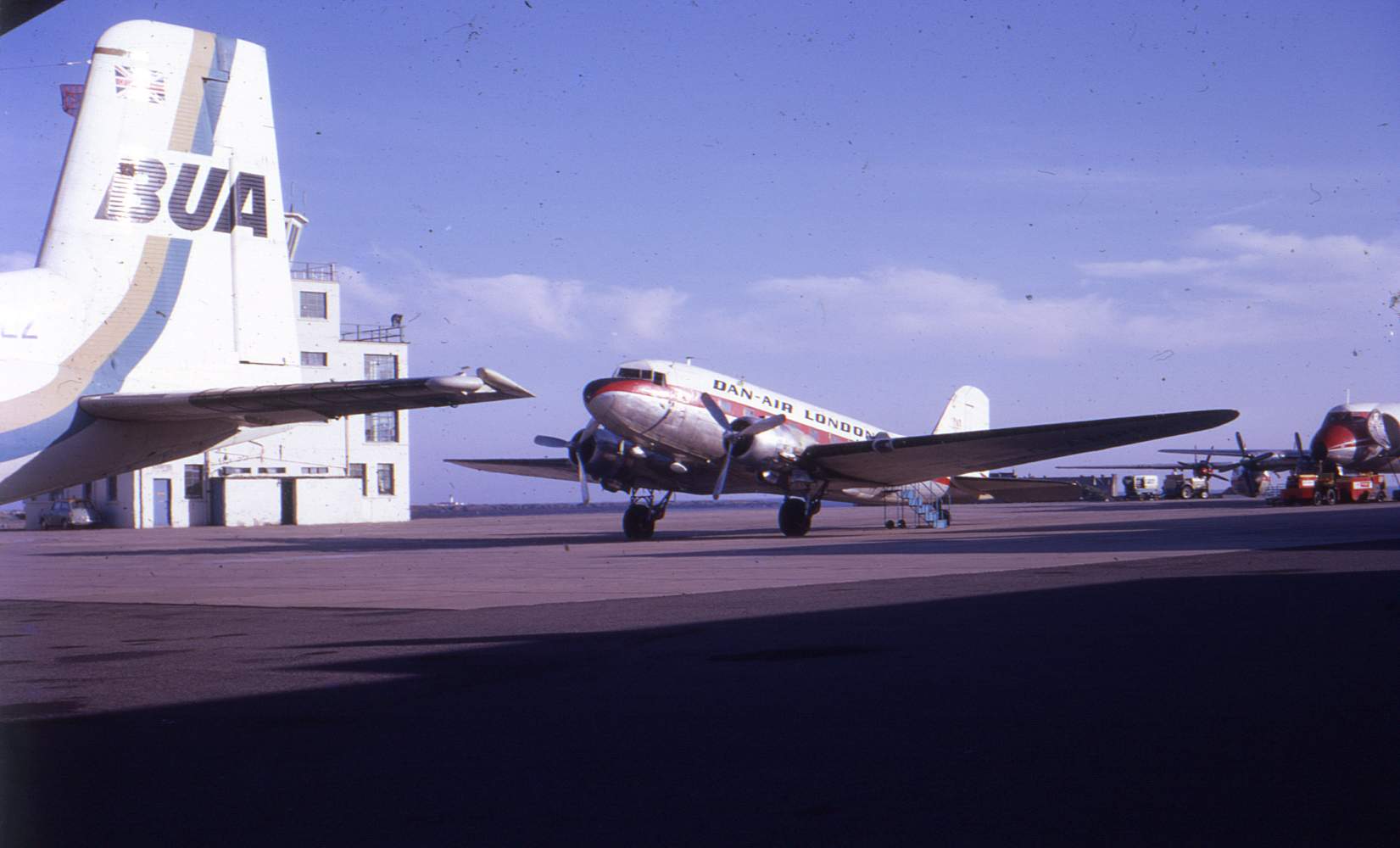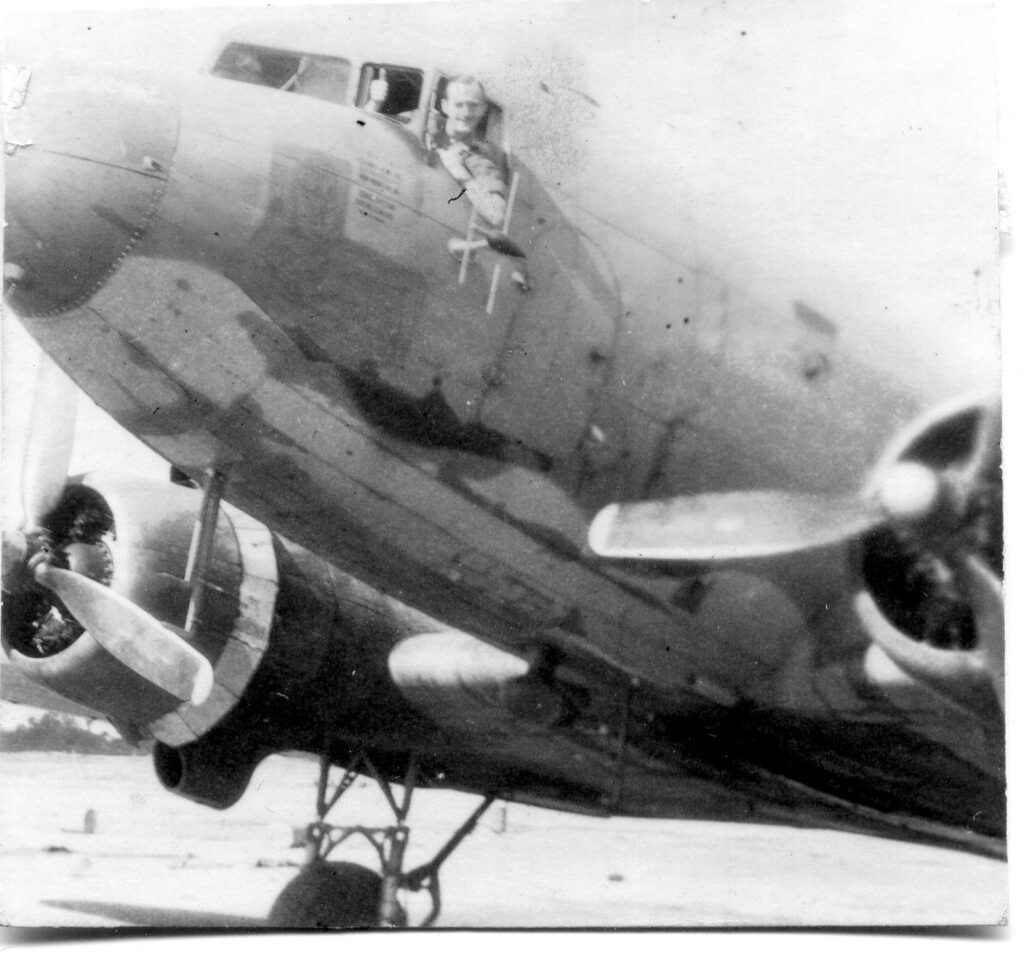
During the first two weeks of August 1945, 233 Squadron were on embarkation leave prior to departing for India. The five Dakotas allocated to the first wave of departures (A), including KG437 manned by Flt Lt Parks crew, completed air tests on August 13th and departed Odiham two days later, each carrying around 20 squadron personnel plus relevant freight. The first leg was the 5 hours 45 min flight to Elmas in Sardinia which was followed by a similar length stage to El Hadem (Tobruk) the following day. Another 3 hours and 15 minutes of flying took the five Dakotas to Lydda Airfield in Palestine on August 17th. On the same day, the second group of five aircraft (B) departed Odiham, again with 20 or so personnel per Dakota, en route to Sardinia.
The first wave continued eastwards on the 18th August with the 3 hour 5 minute flight to the RAF station at Habbaniya in Central Iraq. Their next leg was to Sharjah in the Persian Gulf, a 5 hour 55 minute flight of which the first section was in darkness, probably to reduce turbulence in the heat of the day. Arriving on August 20th, the initial 5 Dakotas were on their way again that night for the 5 hour 5 minute sector to Drigh Road airfield, Karachi. Drigh Road, in present-day Pakistan, was in 1945 the RAF’s main supply and maintenance base for India and Burma and a regular marshaling point for aircraft assigned to South East Asia Command (SEAC). Aircraft assigned to SEAC often carried the title ‘SNAKE’ sprayed on the fuselage next to the serial. This signified that the aircraft was to be delivered directly to SEAC and not misappropriated by needy air force units along the delivery route. It doesn’t seem to be an acronym and it would be interesting to know how the title originated.
The third group of five aircraft (C) departed Odiham on 19th August carrying one hundred and five squadron personnel; the fourth set of five Dakotas set-off on 21st August (D). The final five aircraft departed Odiham on 23rd August and had a slightly more erratic schedule. They needed to pick-up squadron members left behind along the way by previous waves of aircraft, for example owing to sickness or injury. In fact, two aircraft were still in transit on September 3rd when the main squadron was being issued with jungle kit and briefed on Far East life at their new base in India.
The five vanguard aircraft had left Drigh Road for the six hour leg across northern India to Bamrauli Airfield, the long-established Imperial Airways staging post at Allahabad. They arrived on August 23rd and departed the following day on their final five and a half hour flight across what is now Bangladesh to their new home at Tulihal, Imphal, in the state of Assam.
(A) The first wave of aircraft is sparsely documented in the Squadron records but included KG437. KN550 and KN277 may also have been involved.
(B) The second wave comprised KN258, KG420, KG441, KG635 and FZ678.
(C) The third wave: KG433, KJ971, FZ665, KG448, KN427. KJ971 may be a typo as it is not recorded as a 233 Dakota.
(D) The penultimate wave comprised: KG440, KG415, KG559, KG668, KG713. KG668 is not recorded as a 233 aircraft.
The Squadron records don’t list the fifth and final batch of aircraft. KG400 was one of the unrecorded aircraft of the first or fifth wave.
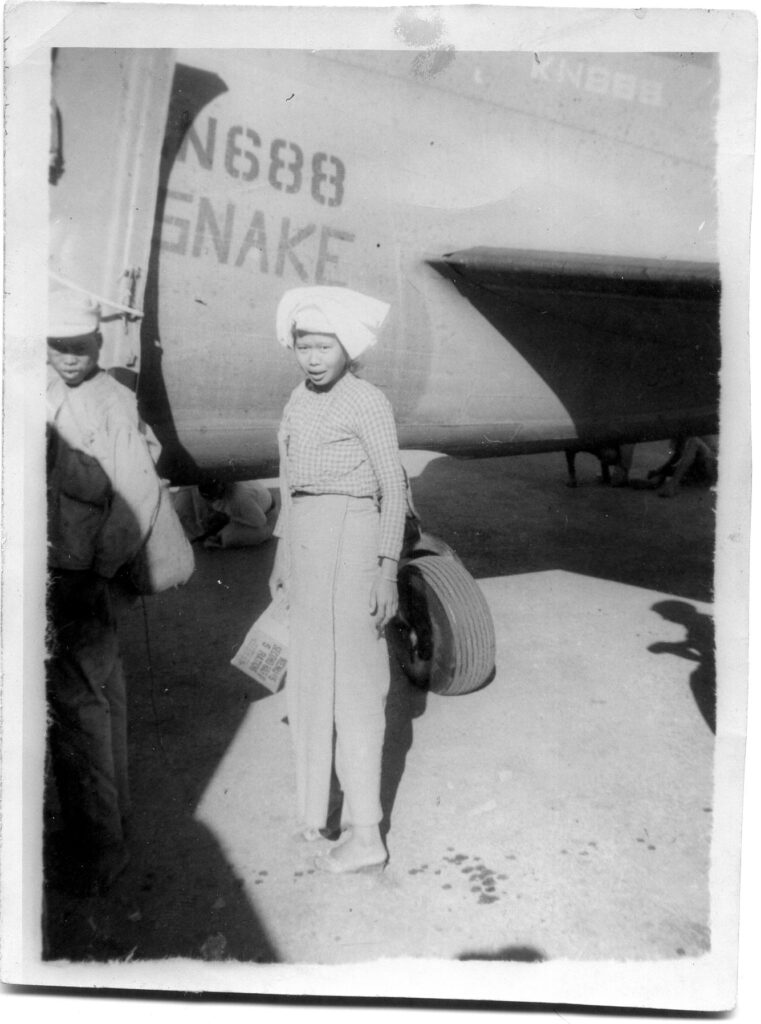
Two Royal Canadian Air Force Dakota squadrons had been formed in India, 435 and 436 Squadrons, and the plan was for them to transfer to Britain to work alongside 437 Squadron, the first and only RCAF Transport squadron formed in Europe. 233 Squadron had moved from their long-established Blakehill Farm base to Odiham in June 1945 prior to departure for India. 437 Squadron had been on detachment in Europe during the spring and early summer of 1945 but now moved to take 233’s place at Odiham. The two Canadian squadrons inbound from India were to take-up residence at the third Cotswold airfield, Down Ampney, where they would replace RAF Dakota units 48 Squadron and 271 Squadron. 48 Squadron, like 233, moved to India to exchange places with 436 Squadron RCAF and 271 Squadron moved to Odiham to replace 233.
It appears that the 233 Squadron aircraft arriving in India were ‘swapped’ for the Dakotas of the two Canadian Squadrons and returned to Britain to be allocated to 435, 436 and 437 Squadrons RCAF *. Many of them went on to return to Canada and have had long lives with local operators (1). Some of the Dakotas flown out by 233 were veterans of earlier European airborne operations and would have been adapted for glider towing. Although this function had been anticipated for 233 in the Far East, the surrender of the Japanese rendered the capability redundant.
Notwithstanding the exchange of aircraft, KG437 did make an operational flight to a Burmese destination on 26th August following its arrival at the Tulihal base the previous day. Flt. Lt Fisher, with Flying Officer Terry Holmes as Navigator, flew 437 on the 3 hour return flight from Tulihal to the airstrip at Bhamo in Burma on the morning of 26th and then operated on another 3 hour round trip to the airfield at Myitkyina. However, the following day, 233 Squadron were flying ex-435 Squadron Dakotas with, for example, KJ902 completing a trip to Myitkyina via an intermediate stop. KJ856, flown by Flt. Lt. Parks, departed the Tulihal base on August 31st en route to Comilla, Kurmitola and Calcutta/ DumDum bases carrying passengers and supplies. Two aero engines were transported on the 3-day return trip which followed the same routing and included delays owing to inclement weather. At the same time, 435 Squadron RCAF was completing its last active mission from India with four Dakotas carrying supplies from Tulihal to a drop zone at Tamu. The Canadians had built-up extensive experience of flying in tropical conditions and documented their knowledge gained from ‘Watchbird’ weather flights. However, with September being the tail-end of the SW Monsoon, the local flying regime would be very different for 233 Squadron crews. Nonetheless, while the Canadian squadrons arriving in the UK were trained for a month in European flying conditions, 233 and 48 Squadrons appear to have been launched straight into tropical flying.
* 48 Squadron RAF transferred from Wiltshire to India alongside 233 Squadron and their Dakotas were exchanged with those of 436 Squadron and the European-spec aircraft returned to UK by the Canadians.
1945 Transport Operations in India & Burma.
The Japanese Army thrust westwards into India had been halted at the Battle of Imphal from March to July 1944. Imphal was an important logistical base for the allies and the repulse of the Japanese and their defeat at the concurrent Battle of Kohima by Indian and British forces proved to be a turning point in the Asian war. The Allied air superiority proved essential with both USAAF and RAF squadrons providing critical supply logistics for both regular army units and the disruptive Chindit special forces. The Royal Canadian Air Force provided two additional Dakota-equipped transport squadrons with 435 Squadron commencing operations from Tulihal on 20th December 1944 and 436 Squadron shortly afterwards. 435 were heavily involved in supply drops to the rapidly-advancing XIVth Army as well as Ord Wingate’s Chindits and their operations were focused on Northern Burma. Living and maintenance facilities were primitive and it was not unknown for groundcrews to be servicing aircraft by torchlight, undoing panels with coins. By the time 435 swapped with 233 Squadron and departed India, they had flown around 30,000 operational hours, carried 27,000 tons of freight and 15,000 passengers and casualties (1).
436 Squadron had a more peripatetic existence from its inception at Kangla, another of Imphal’s six airfields. Unlike Tulihal, Kangla wasn’t an all-weather airfield (2) and the ‘fair weather’ status was a problem during Monsoon months. A 436 detachment was seconded to Ramree Island on the Bay of Bengal coast of Burma. This had been constructed specifically to facilitate monsoon-season operations but, nonetheless, frequently suffered from water-logging. In March 1945, 436 and three RAF Squadrons (62, 194 and 267) moved to the Ayab Air Base (3), also in Burma and on the Bay of Bengal. They are also reported (1) as operating from the USAAF 1st Combat Cargo Group airfield at Hathazari, close to the railhead of Chittagong on the coast of what is, today, Bangladesh (4). On May 10th 1945, the main 436 Squadron joined the detachment at Ramree Island. By the time 436 departed the Far East they had flown around 32,000 operational hours, carried 29,000 tons of cargo and 12,500 passengers and casualties (1).
(1). Details from the Canadian website www.veterans.gc.ca
(2) Tulihal’s main runway was constructed with the Canadian-invented Bit-Hes material – as the name implies, hessian impregnated with Bitumen- which afforded a reasonable landing surface.
(3) Ayab airfield is today known as Sittwe.
(4) Hathazari was used by both RAF and the USAAF 10th Air Force C-46s and C-47s. It appears to have been open only very briefly between April and September 1945. RAF Squadrons 31, 62, 117 and 177 used the base.
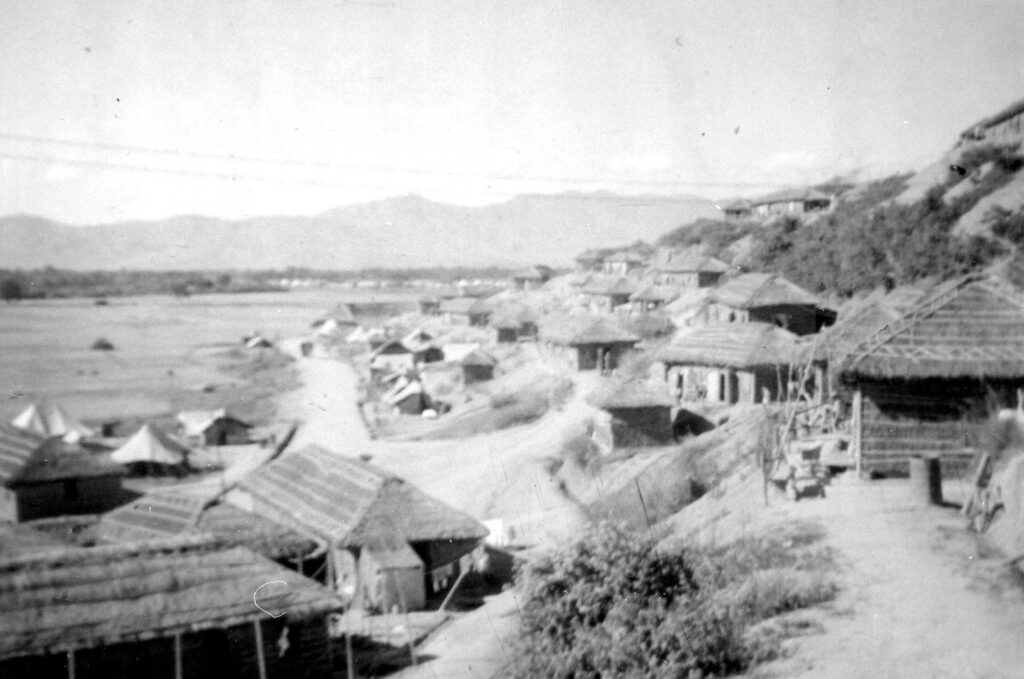
233 Operations in India and Burma.
233 Squadron began to change-out with 435 Squadron from the start of September 1945. As the five-strong batches of aircraft began to arrive from England, 435 began to take over these Dakotas and 233 began to fly the Indian-based aircraft. As with any change out between military units, there was a certain degree of friction as the new arrivals began to move into Tulihal’s Sentinel Hill living accommodation. The Canadians awaiting to travel westwards spent leisure time bidding farewell to Indian friends made during the previous months. Some went tiger hunting, others gathered Japanese skulls from the Imphal battlegrounds – neither occupation being very acceptable by 21st Century standards! 435 seem to have had less problems with local pilfering than 436 Squadron down at Ramree but they did object to the amount of navigation aid equipment removed by 233 Squadron from the European Dakotas. 436 re-equipped some of the returning Dakotas with armchairs and card tables to while away the 6-day trip. Nonetheless, many home comforts had to be left behind and the Canadians found that some treasured possessions were quickly claimed by the new arrivals or, occasionally, added to bonfire piles.
Monsoon-influenced weather continued to complicate operations at the start of September 1945. Ten 233 Squadron aircraft departed Tulihal on the morning of the 1st. carrying rice and rations to destinations such as Haipaw, Myitkyina, Muse, Lashio, Kuthurr and Tougoo but not all were able to deliver their cargoes as planned (4). KN314, unable to drop supplies at Kuthurr, picked-up a second mission to deliver 20 casualties to Chittagong. Despite a 5 hour 15 minute round-trip, KN685 was unable to drop rice at Htawgaw owing to bad weather in the mountains to the east of Myitkyina. KN683 was more fortunate and Warrant Officer J.Salisbury’s crew was able to make a free drop of rice at Hsipaw, the previous seat of government for the Shan States, some 200 km north-east of Mandalay. KJ893, bound for Lahore with Squadron Leader Tim Beddow at the controls also had to abort the mission and return to Tulihal owing to weather limitations. FD878 (5) made the 5 hour 12 minute return flight to Muse, on the border with China, successfully delivering army rations while KN586 caried 5524 lbs of rice to Lashio for distribution to the Shan States. KN169 and KJ898 both had successful missions to Myitkyina, the former carrying rice, the latter food, vaccines and mail.
The remainder of the week followed the same pattern, with most flights crossing the border from Tulihal, in the Indian State of Manipur, to locations in 233 Squadrons operational focus in Northern Burma. Myitkyina, as a major civil and military centre for US, Chinese and British forces following its recapture from the Japanese in August 1944, proved to be a frequent destination as it was the northernmost airfield in Burma and had twin runways. During the earlier part of the war, Myitkyina had been a Japanese fighter base up until May 1944. KN586 and KN685 made the journey to Myitkyina on 2nd September carrying rice and petrol followed by KN321 later in the day, again carrying rice. KN242 flew salt in on September 3rd.
(4) Details of operations are from the RAF Operational logs and diaries accessed via the National Archives of the UK.
(5) If the serial FD878 seems familiar, it may be because FD879 operated for ACSEA as well and probably went on to become ‘Flabob Express’ of the D-Day Squadron fame – see the thread on D-Day Squadron June 2019.
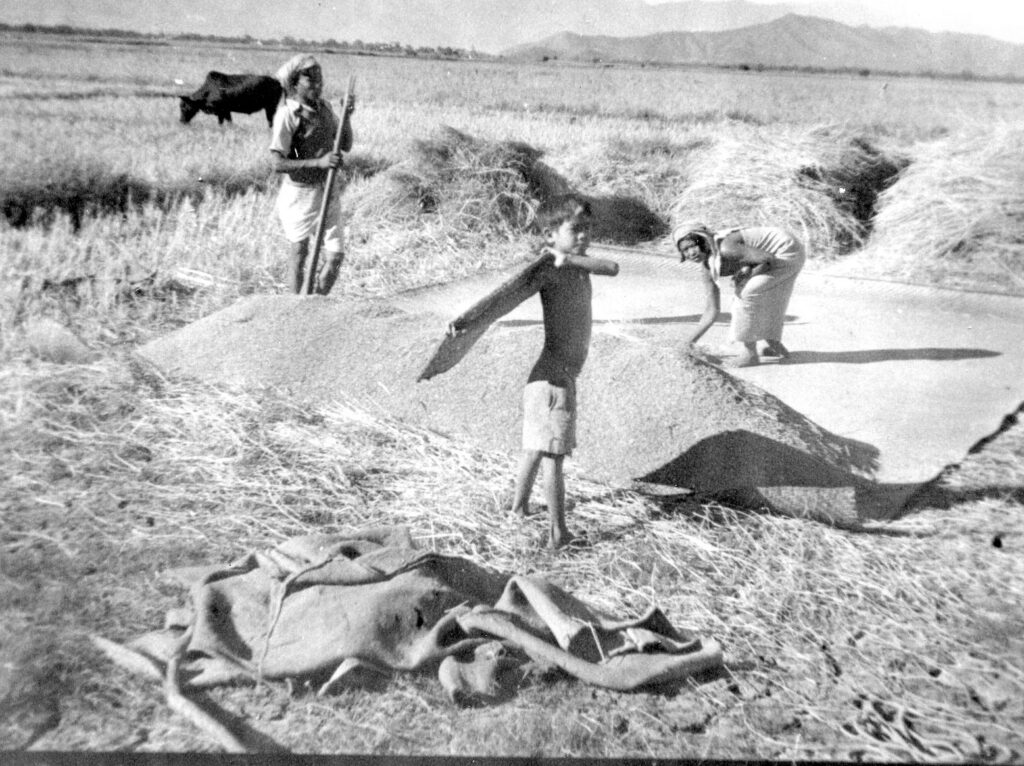
Important targets for re-supply were the northern towns along the Burma Road between Mandalay and Muse on the border with China. This included Hsipaw, a previous seat of the Shan States government, and Lashio. KN321, KK123, KG700 and KN586 delivered rice to Lashio on September 3rd while FD878 also delivered rice before completing a second mission to drop salt at Lonkin. Many of the return sectors from Lashio carried tank parts. Rations were also delivered to Kyaukme, a tea and gemstone-producing town also on the Burma Road, by KK106 on September 2nd and KN321 the following day. Missions were also completed to Kyaukpyu airfield on Ramree Island by KN695 and KN314 (3rd September) and KJ898 made a free rice drop at Homalin, just on the Burma side of the border with India on September 2nd.
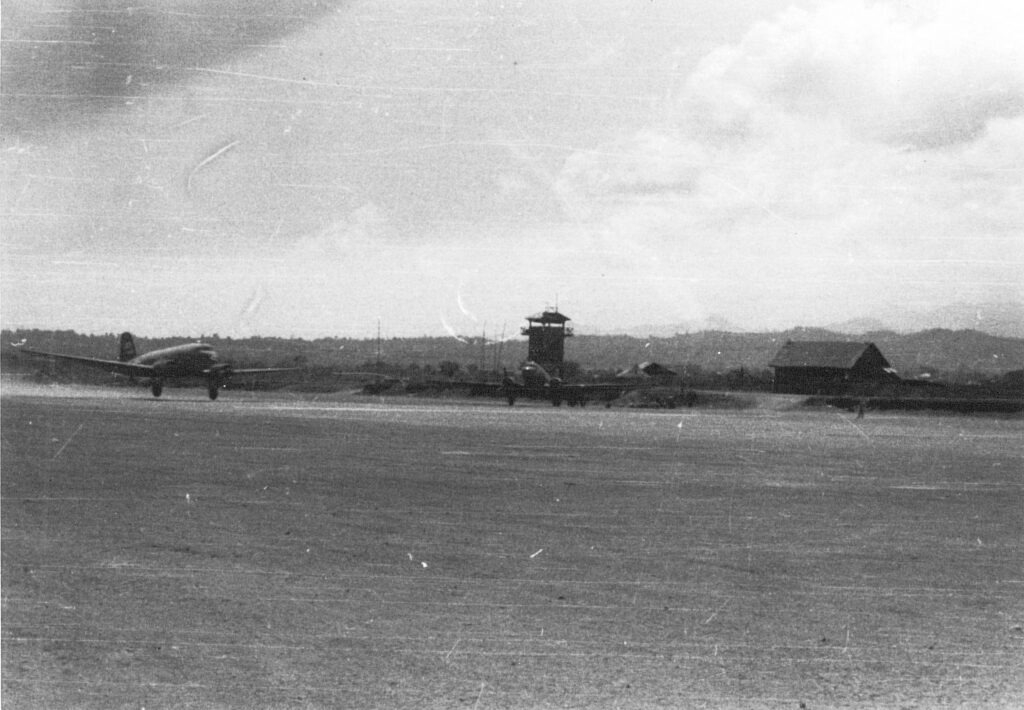
Flying Officer Spinks had experienced engine troubles with KK123 on September 2nd and returned to base. The following day, Flt. Lt. Smith in KG700 also returned to base with engine issues. 435 Squadron had also suffered problems with Twin Wasps and, on September 4th and 5th, it was decided that all aircraft would be considered unserviceable while maintenance routines were brought up to date. Flt. Lt Smith was experiencing a particularly bad start to far East operations as he was injured in a jeep crash on September 5th. Flight Lieutenants Tozer and Morgan were injured in the same crash along with F.O.Baker. Tozer and Smith were senior pilots with 233, both having flown D-Day operations as second pilots in FZ669 and FZ685 respectively. A partial return to operations was made on September 6th but weather curtailed morning flights to Lashio (KN321), Myitkyina (KN314) and Kawlin (KJ898). Second attempts later in the day were successful.
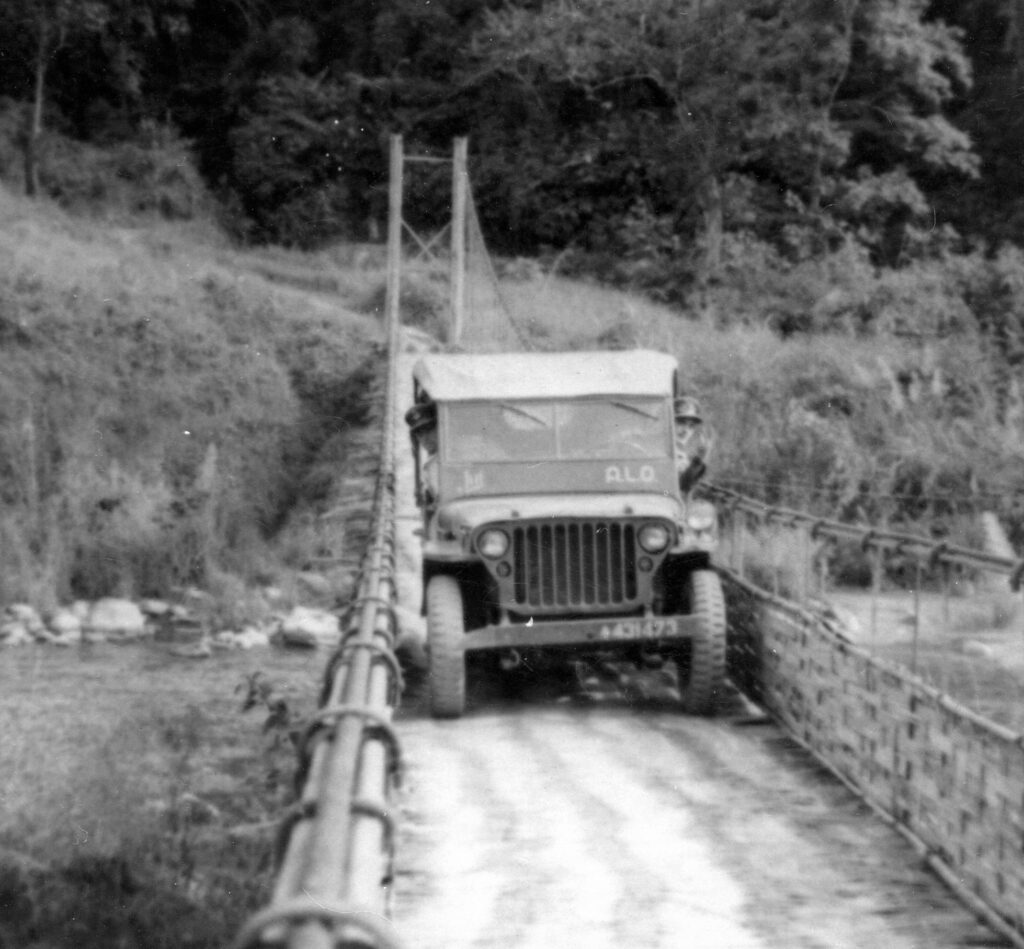
KK169 took 5508 lbs of rice to Lashio and, continuing the run of bad luck with serviceability, went ‘technical’ and remained there for several days. By September 7th, the final contingent of the Squadron had arrived from the UK. Eleven aircraft made 18 trips carrying rice to Lashio (KN242, KN688, KN321, KN685), free drops of rice to Kutkai (KJ888), Langhaung (KN314), Kuyhurr (KJ856 delivering to the Assam Rifles) plus trips to Muse and Myitkyina (KN586 and KJ955 respectively). On 8th and 9th September, morning rains gave way to better conditions in the afternoon. Twelve aircraft performed 22 sorties on 8th with the majority carrying salt, rice and cooking oil to the Northern Shan State airfields of Lashio, Bhamo and Myitkyina and to drop zones at Namtu (FD878), Panglong (KN685), Katha (KJ888) and Htawgan (KN681). Flt Lt. Parks crew comprising Sgt Smith, F.O. Holmes and Flt Sgt Haggis flew KG700 from Tulihal to Chittagong with 20 casualties before returning to base and switching to KK123 for a 2-hour round trip to Muse with supplies.
Much the same pattern of afternoon flying persisted on 9th with 13 aircraft dispatched on 24 missions of which only two proved abortive. Most aircraft and crews were flying double missions each day which could lead to a total of eight or nine flying hours. September 10th and 11th benefited from good weather and the regular sorties were made to the Northern Shan as well as Indian operations to Comilla and Calcutta. KN683 was packed with 30 passengers and mail and flown from Tulihal to Comilla, onwards to Calcutta/ Dum Dum before returning via Kermitola on September 10th. Where airfields such as Muse, Myitkyina, Lashio and Bhamo weren’t convenient, stores were either parachute-dropped or free-dropped on marked drop zones. 435 Squadron had learned that the best drop zones were paddy fields, available clearings and the occasional upland plateau and 233 Squadron would have aimed for similar sites. Some airmen were seconded from 435 to 233 but their function isn’t noted. The crew dealing with dispatching shipments ‘out of the door’ over the drop zones are not documented in the Squadron Operational Record Books except in tragic circumstances. The first operational crash in India occurred on September 12th when KJ902 failed to return from an early morning rice drop to Tiddim, a strategically important village on the border between India and Burma. The pilot, Warrant Officer Evered, was seen to make two unsuccessful attempts to drop the supplies before, on the third run, entering cloud and striking terrain around 1/4 mile south of the drop zone. Flying Officer Elliot’s crew in KN321 had also been unable to drop their consignment on their mission to Haka and, upon return to base, they were transferred to KJ856 and dispatched to search for WO Evered’s Dakota. They located the crash site and dropped first-aid packs although the aircraft was noted to be completely burnt-out. As well as WO Evered, the crew comprised Co-Pilot Sgt Swain, Navigator W.O Tyson, Wireless Operator Sgt Ferris, Ejection Crew Corporal West, Driver Ellis, Driver Lord (all RASC) and Sepoy Naga of the RIASC. WO Evered had been with 233 since D-Day where he had flown as co-pilot in KG403.
Although Tiddim was known to be a destination frequently troubled by weather issues, an investigative team was dispatched and remained in the field for over 10 days. The eight bodies had been recovered by September 28th and interred at the Tiddim Military Cemetery. Regular operations continued on September 13th, although one of the early departures to Lashio, KN685, returned to base with engine trouble. Three Dakotas were due for secondment to Toungoo, an oil town in the Southern Shan States midway between Mandalay and Rangoon. However, further engine issues meant that only two of the aircraft departed on 14th with the third only after repair the following day. KJ681 remained at Toungoo until 23rd September, KJ888 was changed-out on 25th and KN685 on 27th. KK106 also contributed to the operation until the end of the month. Heavy afternoon cloud on 16th combined with low serviceability to limit operations although, generally, deliveries and drops of rice, dhal, rations, salt, medical supplies, mail, soap and even cash (accompanied by escorts!) continued unabated during mid-September.

The 22nd was the most productive day since the Squadron’s arrival in India with 52 tons of cargo delivered by 11 Dakotas on 24 sorties to 9 drop zones and five airfields. The Toungoo detachment had also enjoyed a successful week with 50 out of 57 sorties completed successfully. Plaudits were received from the army ground units appreciative of the swift response to requests and the mostly accurate low-level drops under the cloud base. In one case, troops reported that they were looking directly in to the Dakota cargo door as it passed on its run to the DZ. Efficient coordination between the Squadron and ground forces was maintained by a dedicated Army Liaison Officer who occasionally flew on operations.
Aircraft serviceability continued to restrict operations and engine problems persisted. On September 18th, KJ995 was forced to remain overnight at Bhamo owing to oil leaks on the starboard engine. Coincidentally, a Dakota which had been stranded at Bhamo with serviceability issues since the days of 435 Squadron (FD831) was able to return to Tulihal the following day. KJ856 brought much needed new engines to the Squadron base from Barrackpore on 21st September and KN242 delivered another the following day. These would have been very welcome in the next few days as F.O Green, flying KN314, had to abort a supply drop at Haka on 25th owing to an oil leak on the starboard Twin Wasp. On the same day, FD878 5 minutes into a flight to Myitkyina, had to turn-back owing to an unserviceable port engine. The tail-end of the monsoon season continued to provide challenges with a low cloud base often down to a few hundred feet and towering cumulo-nimbus clouds reportedly stretching as high as 40,000′. The Canadian squadrons had contributed to knowledge of flying in Monsoon conditions with their ‘Watchbird’ weather flights. They maintained that flying through the Cumulo-Nimbus clouds was safer than trying to get down beneath the cloud base and that the danger of airframes being torn apart by violent gusts within the clouds was overstated. 436 Squadron aimed to do most operational flying at 8-9000′ altitudes.
26th September saw a second 233 Squadron aircraft loss with FL526 crashing close to its drop zone at Pangalong. The Dakota and its crew were flying a second morning mission having already flown a 3 hour 15 minute mission to drop supplies at Namtu. By midday, a low cloud base at 400′ was reported at Pangalong and the Dakota was seen to crash into trees around 13:00. The following day, troops arrived from Lashio and found that two of the kickers and both pilots had been killed while the Navigator, Wireless Operator and one of the ejection team had survived. The Dakota was crewed by Flt. Lt. J. Fisher, the Captain, who had been with 233 since late April 1945, F.O. J.L. Osler (Co-pilot), P.O. F.Rains (Navigator), W.O J.Pollitt (Wireless Operator), Corporal R.Cooper, L.Corporal Forster and L.Cpl D.Hudson (all of the Ejection crew). Other aircraft performing multiple missions on 26th included Flt Lt. Parks’ crew in KK123 which departed Tulihal at 07:05 en route to Falam in Burma for a free drop of supplies and parachute drop of salt. Subsequent missions took KK123 to Lashio with rice in the early afternoon and to Bhamo with rice and supplies in the evening.
On the last day of the month, two Dakotas dropped supplies to the Kichen Rifles while four aircraft delivered rice, meat and supplies near Toungoo to the cryptically-named Force 136, ‘Hyena Red’ (6).
(6) Force 136 was a Special Operations Executive organisation comprising British, Burman, Karen and minority soldiers trainey September 1945, there were four groups on the ground in Burma including ‘Hyena’.
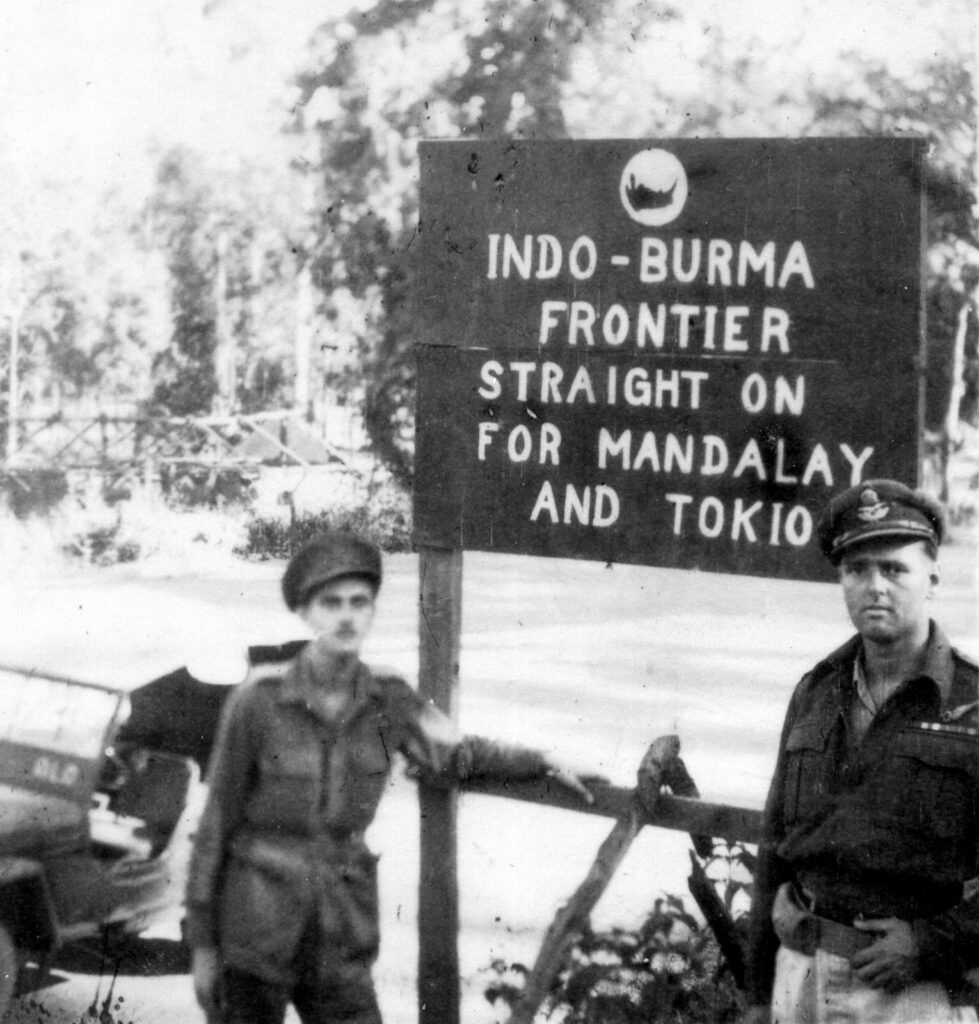
October 1945.
The second month of the Squadron’s Indian operations commenced in much the same way as September had ended with rice and rations, passengers and mail being delivered to the available airfields and supply drops made to villages and ground forces. Aircraft and crews flew two to three missions per day with adverse weather leading to some cancellations and diversions to secondary drop zones. Army casualties were transported to Alipore and an ENSA troupe was also flown there in the first week. Ammunition for the 2nd Battalion Kichen Rifles was delivered to Myitkyina and the detachment at Toungoo continued to drop supplies to the SOE Force 136, in this case Hyena Green. Maintenance issues prevailed with KJ856 suffering failed hydraulics on October 3rd. The same Dakota was jinxed with bad luck again two days later when flown by Warrant Officer W.Neal’s crew. They lifted from Tulihal a 06:35 on October 5th for a drop of salt at Tiddim. Returning to Tulihal after a successful drop, they took off again at 09:10, again destined for Tiddim. However, engine problems necessitated a return to base and, after mechanical attention, a 10:45 departure for Myitkyina. This mission was aborted owing to weather and subsequently rescheduled as a successful 13:30 departure from Tulihal. It remained the case that morning flights abandoned owing to poor weather were often successful later in the day.
KK106’s morning flight to Katha was successfully completed on the afternoon of October 5th. The same day saw a close call for KN685 when an engine cut-out on take-off and the Captain had to make an emergency landing in a field adjacent to Tulihal air base. Fortunately, crew and aircraft emerged unscathed. Bad weather returned on October 6th and several missions were cancelled. One flight to the drop zone at Namhkam returned to within 30 miles of Tulihal without being able to penetrate cloud cover. Turning east again, Flying Officer Diamond landed the Dakota at Myitkyina with only 15 gallons of fuel remaining in the tanks. Further south, the Toungoo detachment had even more severe issues when Flt. Lt. J.G.Moulder’s crew was lost while flying KK123 to re-supply the Hyena Green force at Tosido. Flt.Lt.Park’s crew had completed an early morning supply drop to Drop Zone 713 with KK123, arriving back at Toungoo at 10:30. After a swift turnaround, Flt.Lt.Moulder, Flt.Sgt M.W.Mackenzie and Flying Officer C.J.Sach took-off in KK123 at 11:00 on their fatal final mission. KN688 was despatched from Toungoo on a search that was, initially, unsuccessful. When the crashed Dakota was located, it was confirmed that the flight crew were all dead but one of the Indian Army ejection crew had survived. The detachment at Toungoo was reduced to KJ955 and KN683 but missions to the appreciative Hyena Green operatives continued.
Two aircraft which had been sent to Barrackpore to collect replacement aero engines had diverted to Comilla on account of the weather but returned to Tulihal on October 6th. Others were also experiencing weather-related issues and a 233 Squadron Dakota, KJ888, was sent to help search for a missing USAAF C-54 on the afternoon of October 7th. Barely into the mission, the Dakota had to turn back with hydraulic issues and made a high speed, no-brakes, no-flaps landing at Tulihal at 16:50, grateful for the long runway.
Poor weather disrupted operations from 8th-10th with several aircraft diverted to alternative drops and Dakota FD931, scheduled to drop at Namhsam, forced to land at Namyaseikil (7) to await better weather. Conditions around Bhamo proved particularly challenging. KN683 made the three hour flight back from Toungoo to Tulihal on 8th owing to the regular Captain, Flt.Lt. Park, being ill. KN242, flown by Flying Officer Longhurst, operated on the ‘milk run’ to Comilla, Alipore and Dum Dum with mail, passengers and freight. Conditions on October 11th improved which led to some aircraft and crews operating very busy schedules: FD878 flown by Flt. Sgt Long, for example, flew a total of 9 hours comprising drops at Falham and Namtu and a flight to Myitkyina. KJ955, flown by Warrant Officer Bayetto and KN586, piloted by Flt.Lt Lumley, also operated triple-headers. Two new Twin Wasps were brought up from Barrackpore and Alipore by KN893 in exchange for 3 redundant engines. On 12th October, KN688 was flown by Flt.Lt Smith on the run to Kurmitola (present-day Dhaka), Comilla and Alipore. FD878 finally managed to collect the three casualties from the FL526 Panglong crash from Lashio. KN683 flew to Barrackpore on 13th to swap-out a further three aero engines. Squadron Leader Beddow returned from Toungoo on the same day, taking-in a supply drop at Drop Zone 685 on the way north.
Operations progressed well during the better weather of October 14th and the cloudy weather of 15th. Triple missions were completed by KN242 and KN693 on 14th, KJ823 on 15th and KK169, KN683 and KN685 on both days. Aero engines were again exchanged via flights to Alipore on 15th and Barrackpore on 16th. KJ898 suffered a hydraulic leak on take-off from Myitkyina North and quickly landed at Myitkyina South to effect a 3-hour repair. The third week of the month also saw better weather enabling ten-aircraft to deliver 40 tons of cargo via 20 missions on 16th. Two further shipments of Twin Wasp engines were received from Alipore, 18 patients from Imphal Hospital were transferred to Chittagong by KJ823 on 20th and ‘monkeys and mice’ were shipped to Tulihal on board KN242 for the Scrub Typhus Experimental Station.
The weather clamped down again and operations were reduced to 9 missions from Tulihal on 21st and none at all on 22nd. Toungoo fared better and the three Dakotas completed nine drops on 21st, ten the following day. Their clients were 12th Army and Force 136. On October 23rd, Tulihal sent KN242 on a meteorological flight but there were no other operations. Fortunately, conditions improved on 24th and 23 missions delivered 49 tons of cargo. Reduced landings were made at Lashio and Myitkyina on 25th owing to poor visibility which persisted at the former until 27th. A new Dakota Mk IV arrived at Tulihal on 26th October and the week ended with fair conditions on 28th enabling drops at six out of the eight locations visited and landings at Katha, Bhamo, Lashio and Myitkyina. FD931 flew down to Rangoon’s Mingladon Air Base to deliver mail and currency. Following a drop at Namhsam on 31st October, KN586 suffered engine problems over the Chin Hills with oil pressure on one Twin Wasp dropping to zero before it cut-out. Flt.Lt Lovett was able to bring the Dakota home to Tulihal safely.
(7) An airstrip/ village with this spelling/ name can’t be located.
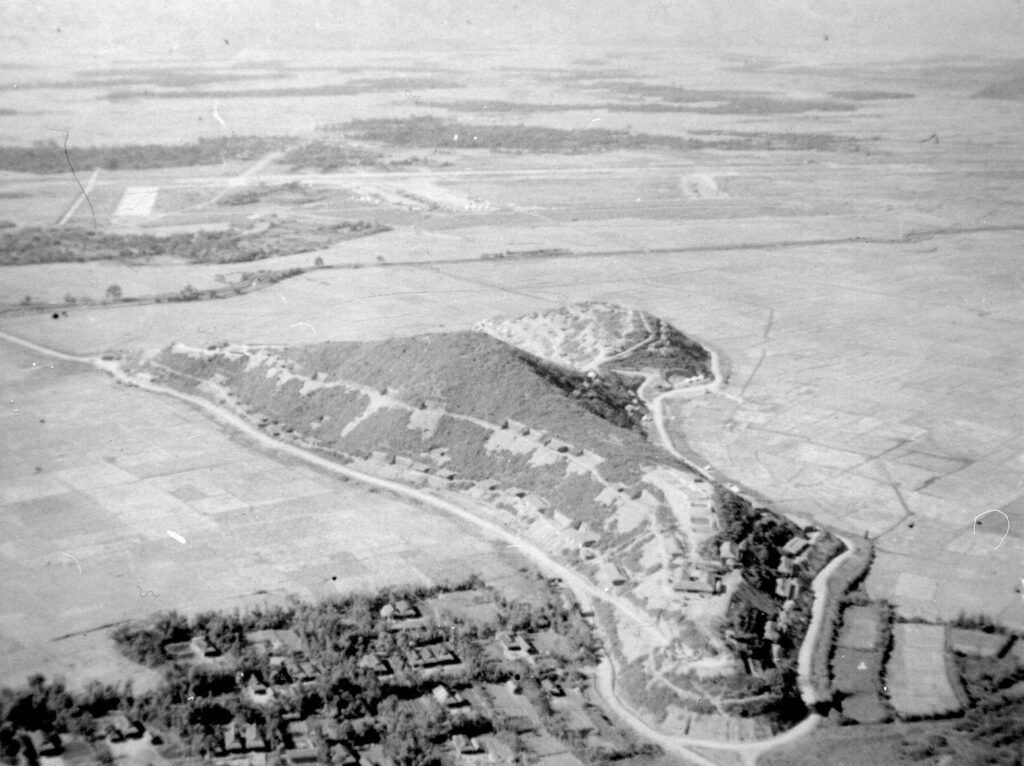
November 1945.
KN698 dropped rations at Tiddim before returning to base to collect a load for Lashio. Upon return, they brought the news that KJ856 had skidded-off the runway at Lashio and had become bogged down. 856 had also flown an earlier mission to Tiddim but had been unable to complete the drop owing to weather. Having been extracted from the mire, KJ856 was able to return to Tulihal on November 5th. Other regular operations continued on the First with KJ844 completing two passenger flights, the first going to Manipur. KJ903 set-off on the regular passenger and mail run to Chittagong, Alipore and Calcutta. The detachment at Toungoo continued support flights for Force 136.
A mishap occurred on 4th November when KN242’s port engine caught fire when taxiing-out for take-off at Myitkyina. As with KJ856, there were no casualties. When weather permitted full operations, the Dakotas and crews were operating three missions per day from Tulihal. Two aircraft, KN693 and KJ955, visited the US base at Fort Hertz delivering salt and collecting empty fuel cans. KJ555 departed on the passenger and mail run to Comilla, Dum Dum and Kurmitola on 5th and KN693 flew in to Tulihal with three aero engines from Barrackpore. More spares were delivered on November 8th; this time it was a large shipment of tyres brought from Dum Dum by KJ903. The end of the monsoon season enabled more effective operations over Northern Burma and, at the same time, flights were operated to Mingladon airfield at Rangoon as the administrative was revived. 233 Squadron’s typewriter ribbon appears to have been wearing thin at the same time and the logs are hard to read. However, it seems to have been ‘business as usual’ to the regular airfields and drop locations. KN681 had electrical problems at Muse on November 11th and an electrician was dispatched on board KN586 which arrived, via Myitkyina, the following day.
Weather on 15th and 16th was good, enabling 12 aircraft to fly rice, dhal, oil, milk and rations to the Northern Shan. KN893 returned two aero engines to Barrackpore. Early fog returned on 17th and 18th with one Dakota having to circle Lashio for 90 minutes awaiting improved visibility. KN685 picked-up several tons of spares from Toungoo on 17th following the return to Tulihal of KK169 on 15th November. KK169’s mission to Myitkyina on 17th was blighted by starter problems and the Dakota remained at the Burmese airfield overnight. Elsewhere, KN683 had serviceability problems on 18th when excessive vibration demanded jettisoning of the payload and a return to base. The problem was fixed expeditiously and 683 manged to get airborne for an afternoon free drop. Another mission on 18th had problems during the parachute drop when the shipment snagged on the aft fuselage and had to be cut free. KJ856 experienced fuel supply problems to the port engine and had to abort its second mission of the day.
Early morning fog continued to be the only really meteorological problem for the rest of November and few flights needed to be aborted. Supplies continued to be delivered by free drop and parachute drop as well as flights to the usual airstrips. Passengers and mail were transferred between Tulihal and Mingladon, Toungoo, Chittagong, Alipore, Comilla and Dum Dum with aero engines delivered to and from Barrackpore. Flight manifests included oil, petrol, ordnance and troop casualties as well as the usual rations and foodstuffs.
December 1945 was the last month of active operations for 233 Squadron in India. Flights to Northern Burma continued apace with seventeen sorties operated on December 3rd once the fog had dissipated. One less than usual mission was the delivery of fuel to Bhamo for what was logged as ‘Chinese’ aircraft on December 9th. Four of the expected Chinese visitors were overdue or missing and a 233 Squadron Dakota was employed on a search mission.
The weather was very poor on December 11th and there was only one movement in each direction from Tulihal: out to Dum Dum and in from Toungoo. Flights to Lashio and Bhamo were aborted owing to the weather on the morning of the 12th but improved as the day wore on. KJ964 flew to Chittagong and KN688 traveled west to Sylhet to collect freight and passengers. The weather was suitable for flights to regular destinations on 13th and two flights were added to Dum Dum. With the end of operations imminent, thirty six Squadron personnel were flown to Pegu (present-day Bago), an airfield to the north-east of Rangoon, in KN685 and KK215. Bad weather returned on the 14th and several drops at Falham, Sumprabum and Haka had to be aborted.
The final day of official operations included sorties to Myitkyina, Lashio, Comilla, and Dum Dum plus three successful parachute drops at Sumprabum to make up for the previous day’s cancellations. The final flight on December 15th was made by KJ893, flown by Warrant Officer Michell, inbound to Tulihal from Myitkyina.
In the following days, some personnel and aircraft were transferred to 215 Squadron: KK215, KN586 and KN681 joined 215, presumably at their home base of Singapore. Some others continued to operate from Tulihal into early 1946 and some of 233’s spares complement was delivered to 267 Squadron on January 2nd. The crew of Flying Officer Simmons was logged as continuing to make the Dum Dum and Barrackpore flights in KJ903 and continued to be signed-off in logs as ‘233 Squadron’ until January 18th 1946. On the following day, KJ903 left Tulihal for Mingladon (Rangoon/ Yangon’s airfield) by way of Meiktila. Flying Officer Simmons crew transferred to 267 Squadron on December 19th and, for the next few months, flew sorties from Mingladon as part of 267’s ‘Airline Service’ to destinations as far afield as Bangkok, Saigon, Penang, Dum Dum, Kuala Lumpur, the Andaman Islands and Singapore. 267 Squadron was itself disbanded at the end of June 1946. Many of the 233 and 267 Squadron personnel were demobbed and returned home, usually by ship, now that the Second World War was over.
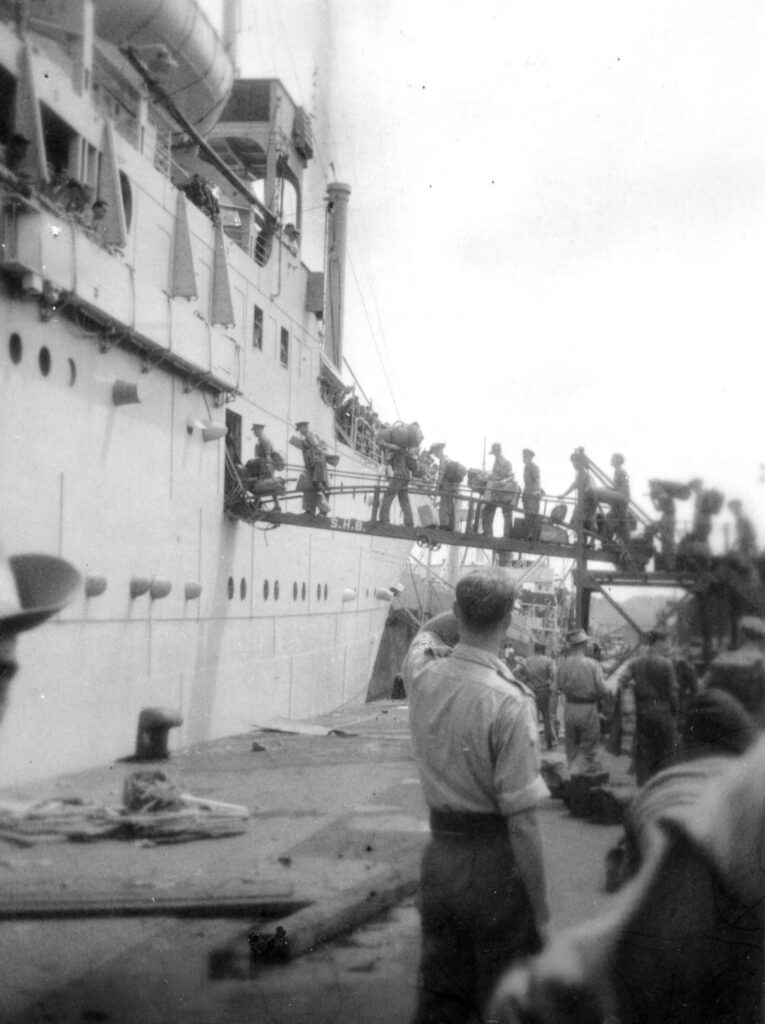
233 Squadron was briefly revived in 1960 when a flight of Vickers Vallettas was detached from 84 Squadron for operations from RAF Khormaksar in Aden. Commencing activities on 1st September 1960, this iteration of the Squadron remained operational until 31st January 1964. Notable work included assistance with flood relief in Lower Juba Province, Somalia, during November and December 1961 via a detachment at Mogadishu.
Hits: 566
